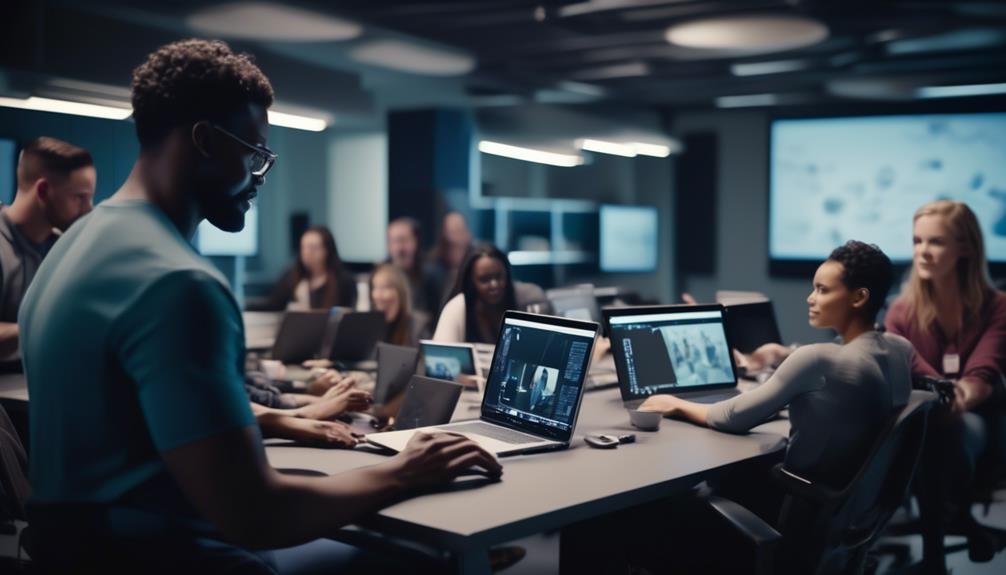How to Effectively Upskill Your Workforce in a Digital Age
In today's fast-paced digital landscape, upskilling the workforce has become a critical necessity for organizations striving to remain competitive. As technology continues to rapidly evolve, the skills required to thrive in the workplace are also constantly shifting.
Effectively upskilling the workforce in a digital age involves a strategic and multifaceted approach that encompasses identifying skill gaps, leveraging online learning platforms, and fostering a culture of continuous learning. However, simply adopting the latest training technologies is not enough.
To truly succeed in upskilling the workforce, organizations must embrace a holistic approach that integrates various learning modalities and actively nurtures a culture of innovation.
Key Takeaways
- Conduct a comprehensive skills assessment to identify skill gaps and deficiencies in your workforce.
- Utilize online learning platforms to address skill deficiencies and provide employees with remote access to training materials and courses.
- Implement hands-on workshops and interactive learning experiences to foster collaboration, problem-solving, and immediate feedback.
- Foster a culture of continuous learning and growth mindset by providing resources for ongoing learning, supporting professional development, and recognizing and rewarding employees for their commitment to continuous learning.
Identifying Skills Gaps
In today's rapidly evolving digital landscape, identifying skills gaps within your workforce is crucial for maintaining a competitive edge and ensuring continued success. Conducting a comprehensive skills assessment is the first step in this process. By evaluating the current skill set of your employees against the skills required to meet the demands of the digital age, you can pinpoint areas that need development. This assessment can take various forms, including surveys, interviews, and performance evaluations.
Once the skills gaps have been identified, the next crucial step is to develop personalized training plans for employees. These plans should be tailored to address the specific skill deficiencies uncovered during the assessment. Providing targeted training not only helps employees acquire the necessary digital skills but also demonstrates a commitment to their professional growth and development. By offering personalized training plans, you can ensure that employees receive the support they need to thrive in the digital age, ultimately contributing to the overall success of your organization.
Assessing Training Needs
Upon identifying the skills gaps within your workforce, the next critical step is to assess the training needs to address the specific skill deficiencies uncovered. This involves conducting a comprehensive training assessment and gap analysis to determine the exact areas where employees require development. Skill mapping and competency evaluation are essential components of this process.
Skill mapping involves identifying the current skills and competencies of your workforce, while competency evaluation helps in understanding the proficiency levels required for each role within the organization.
Training assessment involves a systematic approach to identifying the knowledge and skills required for employees to perform their roles effectively. This can be done through various means such as surveys, interviews, and performance evaluations. Gap analysis then helps to compare the current skills and competencies of employees with the desired skills and competencies, highlighting the areas that need to be addressed through training and development initiatives.
Leveraging Online Learning Platforms
After identifying the training needs of your workforce, leveraging online learning platforms can provide an efficient and flexible way to address skill deficiencies and promote continuous development.
Remote learning has become increasingly prevalent in today's digital age, offering employees the opportunity to access training materials and courses from any location, at any time. This flexibility is particularly beneficial for companies with remote or distributed teams, as it allows employees to upskill without the constraints of physical classroom attendance.
Online learning platforms also play a crucial role in developing digital skills, which are essential in a technology-driven work environment. These platforms offer a wide range of courses covering digital literacy, data analysis, programming, cybersecurity, and other relevant skills. By leveraging these resources, organizations can ensure that their workforce stays updated with the latest technological advancements and industry best practices.
Furthermore, online learning platforms often incorporate interactive and multimedia elements, enhancing the engagement and learning experience for employees. This can result in improved knowledge retention and practical application of newly acquired skills in the workplace.
Implementing Hands-On Workshops
Now, let's turn our attention to the practical side of upskilling: implementing hands-on workshops.
These workshops offer interactive learning experiences that go beyond traditional classroom settings.
Interactive Learning Experiences
Implementing hands-on workshops is an effective way to provide interactive learning experiences for upskilling your workforce in a digital age.
Gamified learning and virtual simulations are powerful tools that can be incorporated into these workshops to enhance employee engagement and knowledge retention. By integrating gamified learning principles, such as awarding points or badges for completing tasks, employees are motivated to actively participate and learn.
Virtual simulations offer a risk-free environment for employees to practice new skills and techniques, allowing them to make mistakes and learn from them without real-world consequences.
Additionally, hands-on workshops provide an opportunity for employees to collaborate, problem-solve, and receive immediate feedback, fostering a dynamic learning experience.
This approach not only enhances skill development but also creates a more engaging and impactful training environment.
Practical Skill-Building Sessions
Conducting hands-on workshops is a practical and effective approach for developing essential skills within your workforce in the digital age. Role-specific training is vital in ensuring that employees acquire the precise skills needed to excel in their respective positions. By tailoring workshops to address the specific requirements of different roles, organizations can provide targeted learning experiences that directly contribute to improved job performance.
Customized learning paths further enhance the effectiveness of practical skill-building sessions by allowing employees to focus on areas that are most relevant to their roles. This personalized approach not only maximizes the impact of the training but also increases employee engagement and motivation.
Engaging Workshop Activities
Developing engaging workshop activities is essential for creating effective hands-on learning experiences that enhance employee skills in the digital age. To ensure successful workshops, consider the following:
- Interactive Simulations: Utilize interactive simulations to provide real-world scenarios and challenges, allowing employees to apply their skills in a practical setting.
- Team Building Exercises: Incorporate team building exercises to foster collaboration and problem-solving skills among employees, encouraging a supportive and cohesive work environment.
- Gamified Learning: Implement gamified learning activities to make the workshop sessions more engaging and enjoyable, promoting healthy competition and active participation.
Encouraging Continuous Learning
To thrive in a digital age, organizations must embrace lifelong learning, fostering a growth mindset among their workforce.
Cultivating curiosity and encouraging exploration are essential in creating an environment where continuous learning is not just encouraged, but expected.
Embracing Lifelong Learning
How can organizations foster a culture of continuous learning to ensure their workforce remains adaptable and competitive in the digital age?
Embracing lifelong learning is crucial for organizations to facilitate continuous improvement and skill retention among their employees. To achieve this, organizations can:
- Provide Learning Resources: Offer access to online courses, webinars, and workshops to support employees in acquiring new skills and knowledge.
- Encourage Knowledge Sharing: Establish a mentoring program or internal knowledge-sharing sessions to facilitate the transfer of expertise among employees.
- Recognize and Reward Learning: Implement a system that acknowledges and rewards employees who actively engage in continuous learning, fostering a culture that values and prioritizes ongoing development.
Fostering Growth Mindset
Encouraging a growth mindset within the workforce is essential for fostering a culture of continuous learning in organizations.
A growth mindset, as opposed to a fixed mindset, emphasizes the belief that abilities and intelligence can be developed through dedication and hard work.
In the context of professional development, fostering a growth mindset among employees can lead to increased resilience, adaptability, and willingness to embrace new challenges.
Employees with a growth mindset are more likely to actively seek out opportunities for learning and skill development, leading to a more agile and future-ready workforce.
Organizations can promote a growth mindset by providing resources for ongoing learning, acknowledging and rewarding efforts to acquire new skills, and creating an environment where taking risks and learning from failures is encouraged.
Cultivating Curiosity and Exploration
Cultivating curiosity and exploration among employees is vital for fostering a culture of continuous learning within organizations. To achieve this, organizations can promote self-directed learning, fostering creativity, and encouraging experimentation, embracing new technologies.
Promoting self-directed learning allows employees to take ownership of their professional development, leading to a more motivated and engaged workforce.
Fostering creativity enables employees to approach challenges with innovative solutions, driving a culture of continuous improvement and adaptability.
Encouraging experimentation and embracing new technologies creates an environment where employees feel empowered to explore new ideas and tools, ultimately driving innovation and growth within the organization.
Providing Mentorship Opportunities
In the rapidly evolving digital age, providing mentorship opportunities for your workforce is essential for fostering continuous learning and development. Mentoring relationships play a crucial role in skill development, allowing employees to benefit from the experience and knowledge of more seasoned colleagues. By pairing less experienced employees with mentors who have valuable expertise, organizations can create a supportive environment that encourages the acquisition of new skills and knowledge.
Mentorship opportunities also facilitate the transfer of tacit knowledge, which is often difficult to codify and transmit through formal training programs. Through regular interactions with their mentors, employees can gain insights into industry best practices, problem-solving techniques, and effective decision-making processes. This personalized approach to learning not only enhances individual skill development but also contributes to a stronger, more cohesive workforce.
Moreover, mentorship opportunities can help employees navigate the complexities of the digital age, particularly in rapidly changing industries. As technology continues to reshape the business landscape, mentors can provide guidance on adapting to new tools, staying updated on industry trends, and honing digital skills. By fostering a culture of mentorship, organizations can empower their workforce to thrive in an ever-evolving digital environment.
Embracing Microlearning Techniques
Embracing microlearning techniques enables organizations to deliver targeted, bite-sized learning modules that cater to the specific needs of employees in the digital age. This approach offers several benefits for digital skill development, including:
- Flexibility: Microlearning allows employees to access training materials at their convenience, fitting learning around their schedules and preferences.
- Engagement: By providing short, focused content, microlearning keeps employees engaged and motivated, leading to better retention of information and skills.
- Customization: Organizations can tailor microlearning modules to address specific skill gaps or emerging trends, ensuring that employees receive the most relevant and up-to-date training.
In the digital age, where skills become obsolete rapidly and employees seek continuous learning opportunities, microlearning proves to be an effective strategy for upskilling the workforce. Its ability to deliver quick, targeted knowledge makes it a valuable tool for organizations looking to keep pace with the ever-changing digital landscape.
Measuring Training Effectiveness
As organizations continue to invest in microlearning techniques to upskill their workforce in the digital age, the need to effectively measure the impact and outcomes of these training initiatives becomes increasingly critical. Measuring training effectiveness involves evaluating outcomes and measuring progress to ensure that the time and resources invested in upskilling employees are yielding the desired results. Employing key performance indicators (KPIs) is essential for assessing the effectiveness of training programs. Some common KPIs for measuring training effectiveness include employee engagement, knowledge retention, application of new skills in the workplace, and overall improvement in job performance.
| KPIs for Measuring Training Effectiveness |
|---|
| Employee Engagement |
| Knowledge Retention |
| Application of New Skills in the Workplace |
| Improvement in Job Performance |
| Return on Investment (ROI) |
Fostering a Culture of Innovation
To cultivate a workplace environment conducive to innovation, fostering a culture that encourages creativity, risk-taking, and continuous improvement is essential. Building an innovation culture within an organization not only promotes employee engagement but also drives digital transformation and creative problem solving.
Here are three key elements to foster a culture of innovation:
- Encouraging Open Communication: Creating an environment where employees feel comfortable sharing their ideas and opinions fosters creativity and innovation. Open communication allows for the free flow of ideas, leading to the generation of new and innovative solutions.
- Empowering Risk-Taking: Encouraging employees to take calculated risks without fear of failure is crucial for fostering innovation. By empowering employees to experiment with new ideas and approaches, organizations can uncover groundbreaking solutions and drive digital transformation.
- Rewarding Continuous Learning: Promoting a culture of continuous improvement and learning incentivizes employees to seek out new knowledge and develop creative problem-solving skills. This not only fosters innovation but also ensures that the workforce remains adaptable and responsive to change.
Conclusion
In conclusion, the effectiveness of upskilling in a digital age is evident through:
- The identification of skills gaps
- Assessment of training needs
- Utilization of online learning platforms
- Implementation of hands-on workshops
- Encouragement of continuous learning
- Provision of mentorship opportunities
- Embracing of microlearning techniques
- Measurement of training effectiveness
- Fostering a culture of innovation
This approach to workforce development ensures that employees are equipped with the necessary skills to thrive in the ever-evolving digital landscape.







